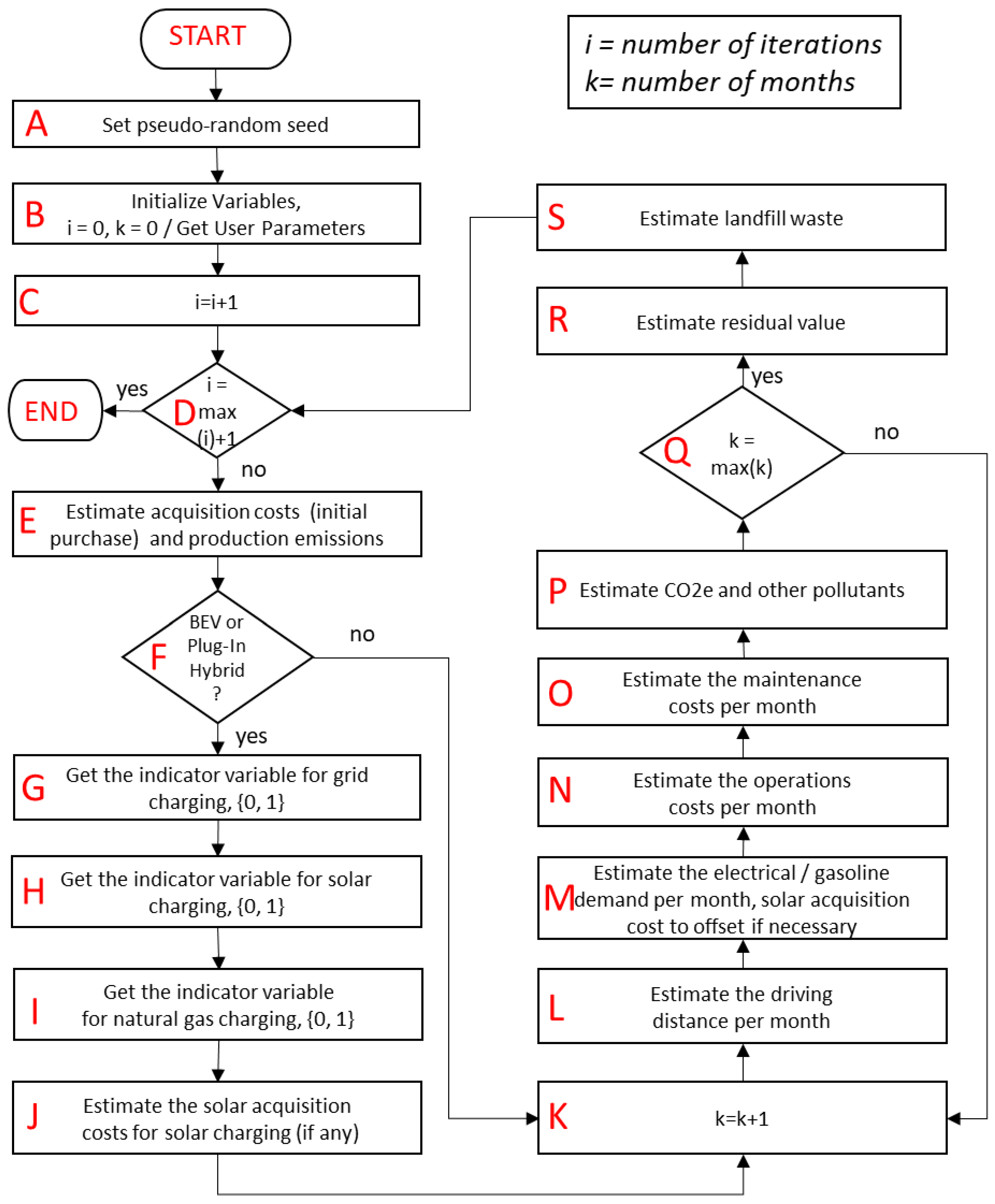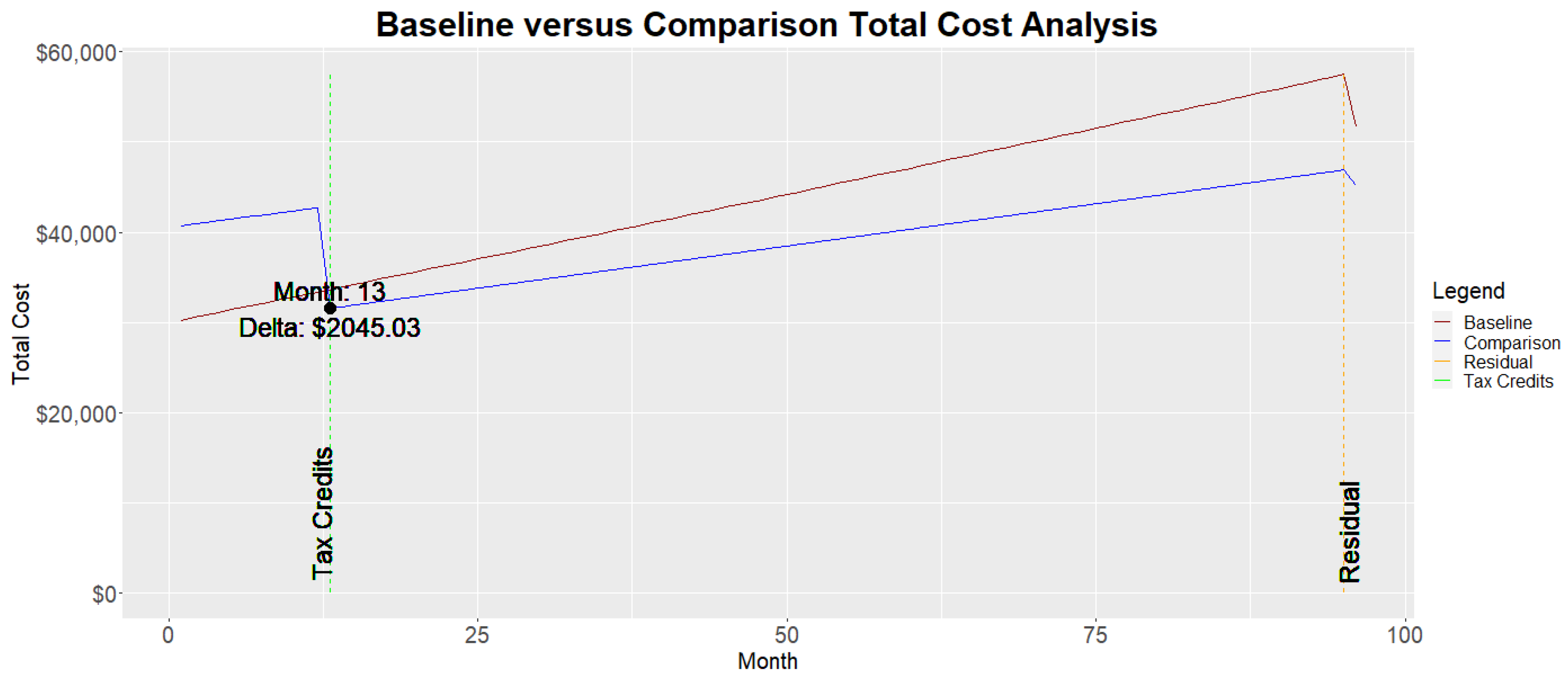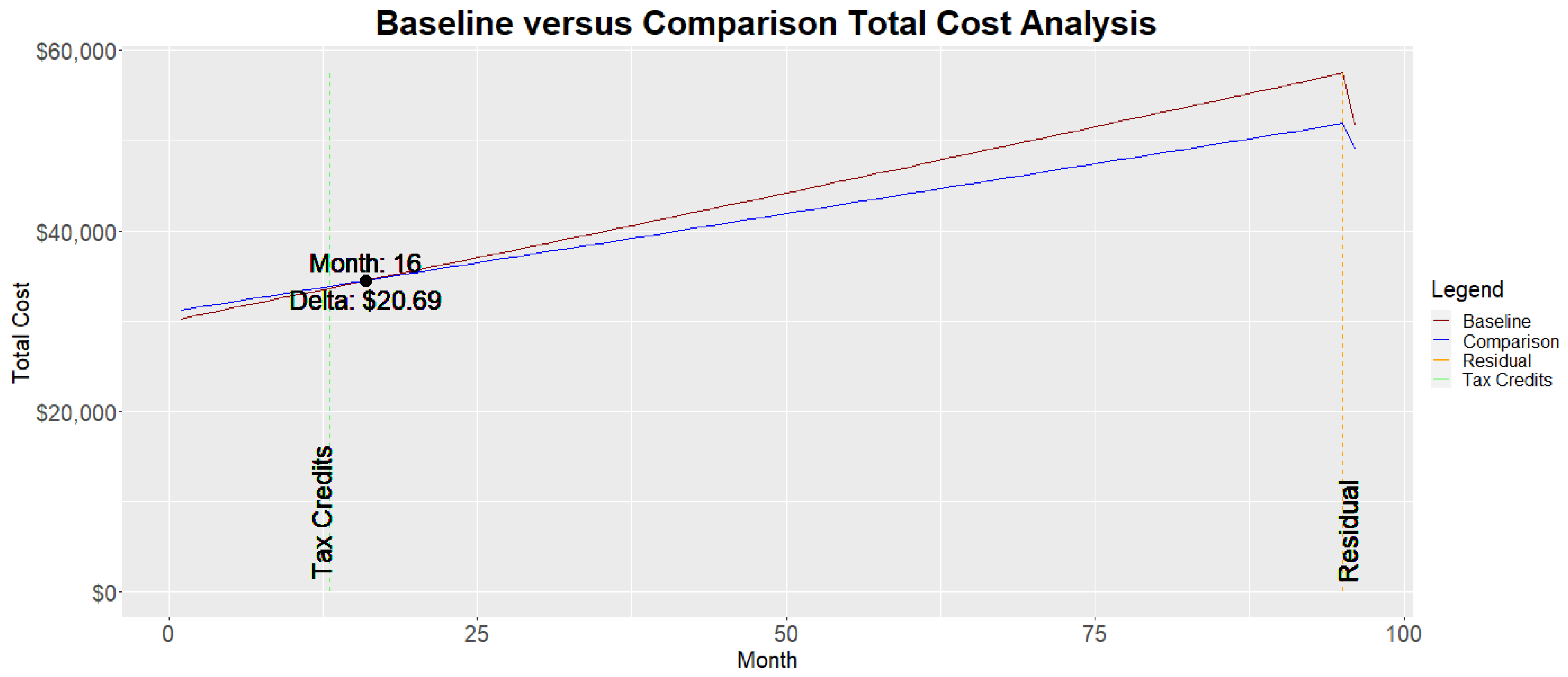A Publicly Available Simulation of Battery Electric, Hybrid Electric, and Gas-Powered Vehicles
Abstract
:1. Introduction
1.1. Necessity for Total Cost of Ownership Analysis
1.2. Environmental Considerations
1.3. TCO of EVs
1.4. Consumer Decision Making in Vehicle Purchasing
1.5. Modeling Considerations
1.6. Study Research Question and Significance
2. Materials and Methods
2.1. Method, Software, and Flowchart
2.2. Simulation Initialization
2.3. Acquisition Costs, Environmental Effects, and Additional Simulation Parameters
Miles × kWh/Mile × $/kWh × % Battery.
2.4. Operations and Maintenance Costs/Solar Acquisition Costs (If Needed)
2.4.1. Miles Driven
(1-GRID) % Natural Gas × % Battery × ($/kWh Natural Gas) × (kWh/mile) × miles +
% Solar x 0 + (1 − % Battery) × ($/gl) × (gl/mile) × miles.
2.4.2. Natural Gas, Electricity, and Regular Gasoline Prices
2.4.3. Insurance and Maintenance Costs
2.4.4. Environmental Costs and Residual Values
2.5. Verification, Validation, and Iterations
3. Results
3.1. Scenario 1: Gasoline versus Electrical Vehicle Charged via Solar
3.2. Scenario 2: Gasoline vs. PHEV
4. Discussion
4.1. Findings and Relationships to Previous Studies
4.2. Energy Savings and Reduced Environmental Impact of Electrical Power Systems for Transportation
4.3. Implications
4.4. Limitations
4.5. Future Improvements
5. Conclusions
Supplementary Materials
Author Contributions
Funding
Conflicts of Interest
References
- Baruník, J.; Křehlík, T. Combining high frequency data with non-linear models for forecasting energy market volatility. Expert Syst. Appl. 2016, 55, 222–242. [Google Scholar] [CrossRef]
- Sheldon, T.L.; DeShazo, J.R.; Carson, R.T. Electric and plug-in hybrid vehicle demand: Lessons for an emerging market. Econ. Inq. 2017, 55, 695–713. [Google Scholar] [CrossRef]
- Coffman, M.; Bernstein, P.; Wee, S. Electric vehicles revisited: A review of factors that affect adoption. Transp. Rev. 2017, 37, 79–93. [Google Scholar] [CrossRef]
- DeLuchi, M.; Wang, Q.; Sperling, D. Electric vehicles: Performance, life-cycle costs, emissions, and recharging requirements. Transp. Res. Part A Gen. 1989, 23, 255–278. [Google Scholar] [CrossRef] [Green Version]
- Fulton, L.; Bastian, N. A Fuel Cost Comparison of Electric and Gas-Powered Vehicles. In Proceedings of the 2012 AutumnSim Conference on Energy, Climate and Environmental Modeling & Simulation, San Diego, CA, USA, 28–31 October 2012. [Google Scholar]
- Beggs, S.; Cardell, S.; Hausman, J. Assessing the potential demand for electric cars. J. Econom. 1981, 17, 1–19. [Google Scholar] [CrossRef]
- Hagman, J.; Ritzén, S.; Stier, J.J.; Susilo, Y. Total cost of ownership and its potential implications for battery electric vehicle diffusion. Res. Transp. Bus. Manag. 2016, 18, 11–17. [Google Scholar] [CrossRef] [Green Version]
- Yu, A.; Wei, Y.; Chen, W.; Peng, N.; Peng, L. Life cycle environmental impacts and carbon emissions: A case study of electric and gasoline vehicles in China. Transp. Res. Part D Transp. Environ. 2018, 65, 409–420. [Google Scholar] [CrossRef]
- Hackney, J.; De Neufville, R. Life cycle model of alternative fuel vehicles: Emissions, energy, and cost trade-offs. Transp. Res. Part A Policy Pract. 2001, 35, 243–266. [Google Scholar] [CrossRef]
- Park, C.; Xing, R.; Hanaoka, T.; Kanamori, Y.; Masui, T. Impact of Energy Efficient Technologies on Residential CO2 Emissions: A Comparison of Korea and China. Energy Procedia 2017, 111, 689–698. [Google Scholar] [CrossRef]
- Xu, B.; Lin, B. Regional differences of pollution emissions in China: Contributing factors and mitigation strategies. J. Clean. Prod. 2016, 112, 1454–1463. [Google Scholar] [CrossRef]
- Coffman, M.; Bernstein, P.; Wee, S. Integrating electric vehicles and residential solar PV. Transp. Policy 2017, 53, 30–38. [Google Scholar] [CrossRef]
- Delucchi, M.A.; Lipman, T.E. An analysis of the retail and lifecycle cost of battery-powered electric vehicles. Transp. Res. Part D Transp. Environ. 2001, 6, 371–404. [Google Scholar] [CrossRef] [Green Version]
- Lipman, T.E.; Delucchi, M.A. A retail and lifecycle cost analysis of hybrid electric vehicles. Transp. Res. Part D 2006, 11, 115–132. [Google Scholar] [CrossRef]
- Ahmadi, P.; Cai, X.M.; Khanna, M. Multicriterion optimal electric drive vehicle selection based on lifecycle emission and lifecycle cost. Int. J. Energy Res. 2018, 42, 1496–1510. [Google Scholar] [CrossRef]
- Palmer, K.; James, E.T.; John, N.; Zia, W. Total cost of ownership and market share for hybrid and electric vehicles in the UK, US and Japan. Appl. Energy 2018, 209, 108–119. [Google Scholar] [CrossRef]
- Prevedouros, P.; Mitropoulos, L. Impact of Battery Performance on Total Cost of Ownership for Electric Drive Vehicle. In Proceedings of the 2018 21st International Conference on Intelligent Transportation Systems (ITSC), Maui, HI, USA, 4–7 November 2018; pp. 1155–1160. [Google Scholar]
- Mitropoulos, L.K.; Prevedouros, P.D.; Kopelias, P. Total cost of ownership and externalities of conventional, hybrid and electric vehicle. Transp. Res. Procedia 2017, 24, 267–274. [Google Scholar] [CrossRef]
- Axsen, J.; Kurani, K.S. Hybrid, plug-in hybrid, or electric—What do car buyers want? Energy Policy 2013, 61, 532–543. [Google Scholar] [CrossRef]
- Danielis, R.; Giansoldati, M.; Rotaris, L. A probabilistic total cost of ownership model to evaluate the current and future prospects of electric cars uptake in Italy. Energy Policy 2018, 119, 268–281. [Google Scholar] [CrossRef]
- Weldon, P.; Morrissey, P.; O’Mahony, M. Long-term cost of ownership comparative analysis between electric vehicles and internal combustion engine vehicles. Sustain. Cities Soc. 2018, 39, 578–591. [Google Scholar] [CrossRef]
- Moon, S.; Lee, D.-J. An optimal electric vehicle investment model for consumers using total cost of ownership: A real option approach. Appl. Energy 2019, 253, 113494. [Google Scholar] [CrossRef]
- Khan, S.; Ahmad, A.; Ahmad, F.; Shafaati Shemami, M.; Saad Alam, M.; Khateeb, S. A Comprehensive Review on Solar Powered Electric Vehicle Charging System. Smart Sci. 2018, 6, 54–79. [Google Scholar] [CrossRef]
- Kelly, J.C.; MacDonald, J.S.; Keoleian, G.A. Time-dependent plug-in hybrid electric vehicle charging based on national driving patterns and demographics. Appl. Energy 2012, 94, 395–405. [Google Scholar] [CrossRef]
- Das, H.S.; Rahman, M.M.; Li, S.; Tan, C.W. Electric vehicles standards, charging infrastructure, and impact on grid integration: A technological review. Renew. Sustain. Energy Rev. 2020, 120, 109618. [Google Scholar] [CrossRef]
- Chandra Mouli, G.R.; Bauer, P.; Zeman, M. System design for a solar powered electric vehicle charging station for workplaces. Appl. Energy 2016, 168, 434–443. [Google Scholar] [CrossRef] [Green Version]
- Fulton, L.; Beauvais, B.; Brooks, M.; Kruse, C.S.; Lee, K. Green for the Environment and Green for the Pocketbook: A Decade of Living Sustainably. Preprints 2020. [Google Scholar] [CrossRef] [Green Version]
- Fulton, L. Ownership Cost Comparison of Battery Electric and Non-Plugin Hybrid Vehicles: A Consumer Perspective. Appl. Sci. 2018, 8, 1487. [Google Scholar] [CrossRef]
- Ernst, C.-S.; Hackbarth, A.; Madlener, R.; Lunz, B.; Uwe Sauer, D.; Eckstein, L. Battery sizing for serial plug-in hybrid electric vehicles: A model-based economic analysis for Germany. Energy Policy 2011, 39, 5871–5882. [Google Scholar] [CrossRef]
- Jaguemont, J.; Boulon, L.; Dubé, Y. A comprehensive review of lithium-ion batteries used in hybrid and electric vehicles at cold temperatures. Appl. Energy 2016, 164, 99–114. [Google Scholar] [CrossRef]
- Lieven, T.; Mühlmeier, S.; Henkel, S.; Waller, J.F. Who will buy electric cars? An empirical study in Germany. Transp. Res. Part D 2011, 16, 236–243. [Google Scholar] [CrossRef]
- Shin, J.; Hong, J.; Jeong, G.; Lee, J. Impact of electric vehicles on existing car usage: A mixed multiple discrete–continuous extreme value model approach. Transp. Res. Part D 2012, 17, 138–144. [Google Scholar] [CrossRef]
- He, L.; Chen, W.; Conzelmann, G. Impact of vehicle usage on consumer choice of hybrid electric vehicles. Transp. Res. Part D 2012, 17, 208–214. [Google Scholar] [CrossRef]
- He, H.; Fan, J.; Li, Y.; Li, J. When to switch to a hybrid electric vehicle: A replacement optimisation decision. J. Clean. Prod. 2017, 148, 295–303. [Google Scholar] [CrossRef]
- Özdemir, E.D.; Hartmann, N. Impact of electric range and fossil fuel price level on the economics of plug-in hybrid vehicles and greenhouse gas abatement costs. Energy Policy 2012, 46, 185–192. [Google Scholar] [CrossRef]
- Silva, C.; Farias, T.; Ross, M. Evaluation of energy consumption, emissions and cost of plug-in hybrid vehicles. Energy Convers. Manag. 2009, 50, 1635–1643. [Google Scholar] [CrossRef]
- Werber, M.; Fischer, M.; Schwartz, P.V. Batteries: Lower cost than gasoline? Energy Policy 2009, 37, 2465–2468. [Google Scholar] [CrossRef]
- Weiller, C. Plug-in hybrid electric vehicle impacts on hourly electricity demand in the United States. Energy Policy 2011, 39, 3766–3778. [Google Scholar] [CrossRef]
- Fulton, L.; McMurry, L.T.C.P.; Kerr, C.O.L.B. A Monte Carlo Simulation of Air Ambulance Requirements During Major Combat Operations. Mil. Med. 2009, 174, 610–614. [Google Scholar] [CrossRef] [Green Version]
- R Core Team. R: A Language and Environment for Statistical Computing; R Core Team: Vienna, Austria, 2018. [Google Scholar]
- Chang, W.; Cheng, J.; Allaire, J.J.; Xie, Y.; McPherson, J. Shiny: Web Application Framework for R. 2019. Available online: https://shiny.rstudio.com/reference/shiny/1.4.0/shiny-package.html (accessed on 1 May 2020).
- LowCVP. LowCVP Study Demonstrates the Increasing Importance of Measuring Whole Life Carbon Emissions to Compare Vehicle Performance. Available online: https://d1v9sz08rbysvx.cloudfront.net/ricardo/media/media/news%20assets/lowcvp%20study%20demonstrates%20importance%20of%20whole%20life%20co2%20emissions.pdf (accessed on 27 April 2020).
- Barbose, G.; Darghouth, N. Tracking the Sun|Electricity Markets and Policy Group. 2019. Available online: https://emp.lbl.gov/tracking-the-sun (accessed on 27 April 2020).
- Fulton, L.; Bradley, B.; Matthew, B.; Clemens Scott, K.; Lee, K. A Publicly Available Cost Simulation of Sustainable Construction Options for Residential Houses. Sustainability 2020, 12, 2873. [Google Scholar] [CrossRef] [Green Version]
- Average Annual Miles per Driver by Age Group. Available online: https://www.fhwa.dot.gov/ohim/onh00/bar8.htm (accessed on 27 April 2020).
- U.S. Energy Information Administration (EIA). Available online: https://www.eia.gov/ (accessed on 27 April 2020).
- Hyndman, R.A.G. Forecasting: Principles and Practice; OTexts: Melbourne, Australia, 2019. [Google Scholar]
- Breetz, H.L.; Salon, D. Do electric vehicles need subsidies? Ownership costs for conventional, hybrid, and electric vehicles in 14 U.S. cities. Energy Policy 2018, 120, 238–249. [Google Scholar] [CrossRef]
- Total Cost of Ownership of an Electric Car|PluginCars.com. Available online: https://www.plugincars.com/eight-factors-determining-total-cost-ownership-electric-car-127528.html (accessed on 21 April 2020).
- Xia, Y.; Yang, J.; Liu, Z.; Dong, J. Cost-Effectiveness Analysis of Plug-In Hybrid Electric Vehicles using Vehicle Usage Data Collected in Shanghai, China. Transp. Res. Rec. 2019, 2673, 251–261. [Google Scholar] [CrossRef]
- Alternative Fuels Data Center: Emissions from Hybrid and Plug-In Electric Vehicles. Available online: https://afdc.energy.gov/vehicles/electric_emissions.html#wheel (accessed on 21 April 2020).
- E.P.A. Federal and California Light-Duty Vehicle Emissions Standards for Air Pollution, EPA-420-B-19-043. 2019. Available online: https://nepis.epa.gov/Exe/ZyPDF.cgi?Dockey=P100XCIV.pdf (accessed on 21 April 2020).
- Randolph, J.; Masters, G.M. Transportation Energy and Efficient Vehicles. In Energy for Sustainability: Foundations for Technology, Planning, and Policy; Randolph, J., Masters, G.M., Eds.; Island Press/Center for Resource Economics: Washington, DC, USA, 2018; pp. 389–428. [Google Scholar] [CrossRef]
- Moody’s. Electric Vehicle Residual Value Outlook. Available online: https://www.moodysanalytics.com/-/media/presentation/2017/electric-vehicle-residual-value-outlook.pdf (accessed on 28 April 2020).
- Harper, G.; Sommerville, R.; Kendrick, E.; Driscoll, L.; Slater, P.; Stolkin, R.; Walton, A.; Christensen, P.; Heidrich, O.; Lambert, S.; et al. Recycling lithium-ion batteries from electric vehicles. Nature 2019, 575, 75–86. [Google Scholar] [CrossRef] [PubMed] [Green Version]
- Berjoz, D.J.I. Influence of batteries weight on electric automobile performance. Eng. Rural Dev. 2017, 24, 1388–1394. [Google Scholar]
- Ma, S.X.; Junping, J.; Xiao, M. Comparative Life Cycle Energy and GHG Emission Analysis for BEVs and PhEVs: A Case Study in China. Energies 2019, 12, 834. [Google Scholar] [CrossRef] [Green Version]
- Narassimhan, E.; Johnson, C. The role of demand-side incentives and charging infrastructure on plug-in electric vehicle adoption: Analysis of US States. Environ. Res. Lett. 2018, 13, 074032. [Google Scholar] [CrossRef] [Green Version]
- Falahati, B.; Shahverdi, M.; Mohajeryami, S.; Fajri, P. Examining the impact of PHEVs on GHG emissions based on various objectives. In Proceedings of the 2017 IEEE Conference on Technologies for Sustainability (SusTech), Phoenix, AZ, USA, 12–14 November 2017; pp. 1–5. [Google Scholar]
- Li, J.; Yang, B. Analysis of greenhouse gas emissions from electric vehicle considering electric energy structure, climate and power economy of ev: A China case. Atmos. Pollut. Res. 2020. [Google Scholar] [CrossRef]
- Guo, Z.; Zhou, Y. Residual value analysis of plug-in vehicles in the United States. Energy Policy 2019, 125, 445–455. [Google Scholar] [CrossRef]
- Manjunath, A.; Gross, G. Towards a meaningful metric for the quantification of GHG emissions of electric vehicles (EVs). Energy Policy 2017, 102, 423–429. [Google Scholar] [CrossRef]
- EEI Celebrates 1 Million Electric Vehicles on U.S. Roads. Available online: https://www.eei.org/resourcesandmedia/newsroom/Pages/Press%20Releases/EEI%20Celebrates%201%20Million%20Electric%20Vehicles%20on%20U-S-%20Roads.aspx (accessed on 30 April 2020).
- Falahati, S.; Taher, S.A.; Shahidehpour, M. A new smart charging method for EVs for frequency control of smart grid. Int. J. Electr. Power Energy Syst. 2016, 83, 458–469. [Google Scholar] [CrossRef]
- Kapustin, N.O.; Grushevenko, D.A. Long-term electric vehicles outlook and their potential impact on electric grid. Energy Policy 2020, 137, 111103. [Google Scholar] [CrossRef]
- Hidrue, M.K.; Parsons, G.R.; Kempton, W.; Gardner, M.P. Willingness to pay for electric vehicles and their attributes. Resour. Energy Econ. 2011, 33, 686–705. [Google Scholar] [CrossRef] [Green Version]






| Parameter/Variable | Options | Default |
|---|---|---|
| Month of purchase | January, February,…December | April |
| Year of purchase | 2020, 2021, 2022 | 2020 |
| State of use | 50 states | Texas |
| Vehicle Type | Gas, NPHEV, PHEV, BEV | Gas |
| Residential Power for EV | Electric, Natural Gas, Solar | Electric |
| Monthly Driving Distance | 100 to 20,000 miles | 1100 miles |
| Years of Ownership | 1 to 10 | 8 years |
| % of Vehicle Power by Battery | 0 to 100 | 0% |
| Vehicle Purchase Cost | $10,000 to $20,000 | $30,000 |
| Miles Per Gallon (Gas) | 0 to 120 | 30 MPG |
| Tax Credit | 0 to 30% | 0% |
| EV kWh/mile | 0.2 to 0.5 | 0.34 EV kWh/mile |
| Charging Station Cost for Home | $0 to $3000 | $0 |
| Cost of Solar Panels: $/Watt | $2 to $5 | $3.3 |
| Vehicle Type | Estimated Lifecycle Emissions (Tonnes CO2e) | Proportion of Emissions from Production | Estimated Emissions in Production (Tonnes CO2e) |
|---|---|---|---|
| ICEV | 24 | 23% | 5.6 |
| NPHEV | 21 | 31% | 6.5 |
| PHEV | 19 | 35% | 6.7 |
| BEV | 19 | 46% | 8.8 |
| Vehicle Type | NOx + NMOG, mg/mile | CO2, g/mile | CO, g/mile | PM, mg/mile |
|---|---|---|---|---|
| ICEV | 160 | 475 | 4.2 | 10 |
| NPHEV * | 128 | 323 | 3.0 | 10 |
| PHEV | 95 | 170 | 2.1 | 10 |
| BEV | 0.07 | 0 | 0.0 | 0 |
© 2020 by the author. Licensee MDPI, Basel, Switzerland. This article is an open access article distributed under the terms and conditions of the Creative Commons Attribution (CC BY) license (http://creativecommons.org/licenses/by/4.0/).
Share and Cite
Fulton, L. A Publicly Available Simulation of Battery Electric, Hybrid Electric, and Gas-Powered Vehicles. Energies 2020, 13, 2569. https://doi.org/10.3390/en13102569
Fulton L. A Publicly Available Simulation of Battery Electric, Hybrid Electric, and Gas-Powered Vehicles. Energies. 2020; 13(10):2569. https://doi.org/10.3390/en13102569
Chicago/Turabian StyleFulton, Lawrence. 2020. "A Publicly Available Simulation of Battery Electric, Hybrid Electric, and Gas-Powered Vehicles" Energies 13, no. 10: 2569. https://doi.org/10.3390/en13102569
APA StyleFulton, L. (2020). A Publicly Available Simulation of Battery Electric, Hybrid Electric, and Gas-Powered Vehicles. Energies, 13(10), 2569. https://doi.org/10.3390/en13102569





